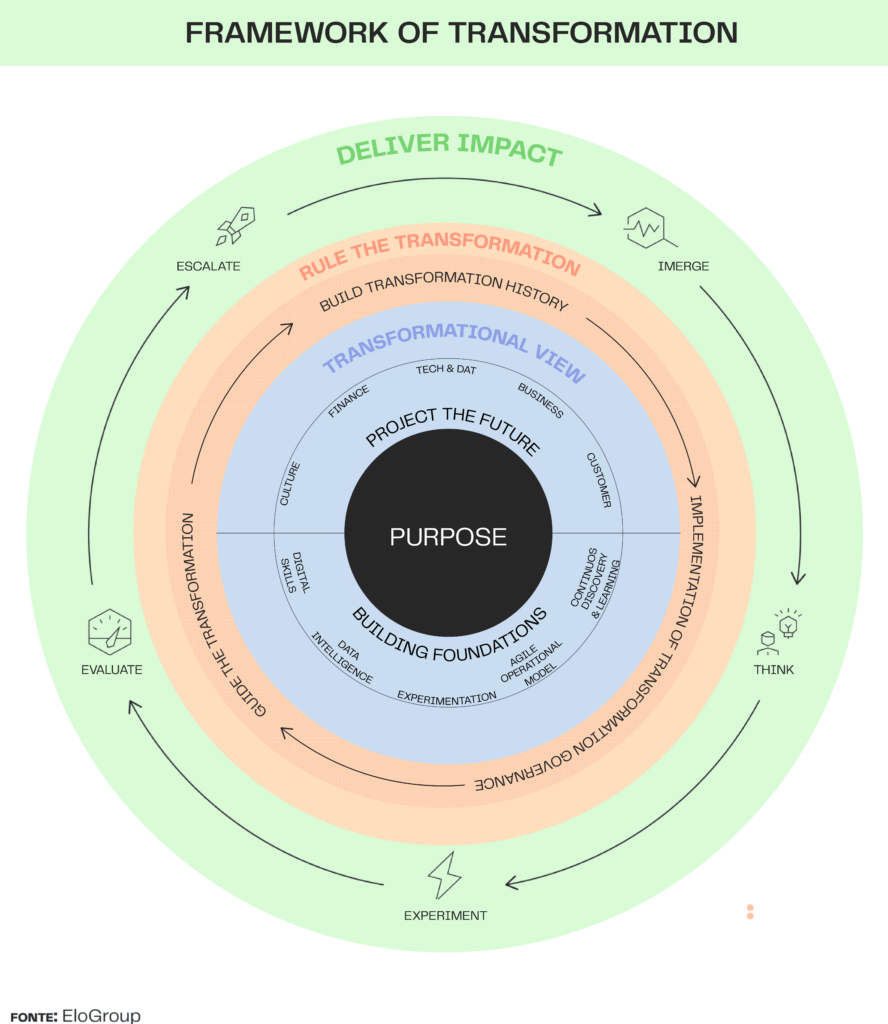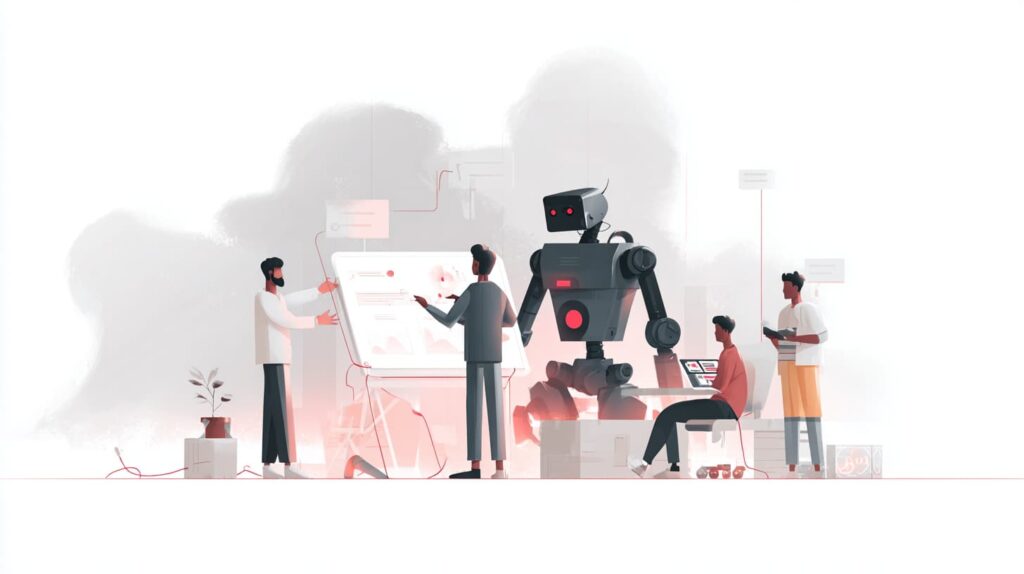By EloInsights, in collaboration with Marcos Navarini
- In this final article in the series on the Great Battles of Transformation, we will discuss building foundations that enable change as a continuous process.
- The goal is to make the organization driven by change, with a natural ability to renew itself in the face of new challenges.
- Foundations involve the development of digital competences, data intelligence, a culture of experimentation and the application of agile methods at scale, as well as continuous exploration and learning.
We have reached the end of the series of four articles on the Great Battles of Transformation in the organizational context. After projecting the future, setting up governance mechanisms, generating value and the impact of transformation, we are now going to focus on building the foundations that will enable continuous change, rather than a one-off, isolated movement.
The aim is to create the foundations for the organization to become driven by change, thus gaining the natural ability to renew itself in the face of new challenges that tend to arise more and more quickly in a context of constant technological, social and economic disruption. This is what we call “metatransformation” (a type of transformation that creates the foundations and enables other transformations).
For this to happen, it is important for the organization to cultivate five foundational elements:
Digital competences
This involves establishing a logic in which technology is a lens and the technical teams approach the business area to take part in strategic decisions and find the affordance (or different possible uses) of enabling technologies.
Redesigning system architectures in a way that allows for continuous and rapid deploys of features by independent teams is also key at this stage of building foundations. Other foundational tech capabilities, such as mastering low-code tools and migrating the infrastructure to the cloud, allow the transformation to take place more quickly. But it is important to remember that business awareness is key to getting the adoption of these digital competences right.
Data intelligence
It is essential that organizations develop a strong data-driven culture, and that decision-making is increasingly supported by data intelligence. To this end, it is important to guarantee not only the availability but also the quality of data, a fact that is often overlooked in transformations.
The use of more data science and the attraction of data engineers are also premises, and tend to involve changes in organizational design, such as the implementation of devices as centers of excellence in advanced analytics. The use of data is important as a lever for transformation, as it helps to validate it and enables a way of metricizing and evaluating success based on data, as we will cover in the next topic.
Experimentation
This is another of the fundamental capabilities in enabling a driven by change culture, bringing an evidence-based, user-centered experimentation process into the working dynamic, using rapid tests on behaviors and preferences for decision-making.
This is mainly tangible in A/B testing, applied in the context of customer experience in digital products. However, it can be applied to any type of transformation, when absorbed into the organization’s modus operandi.
To do this, it is essential to target the work on hypotheses, devise tests that can be applied quickly and agree on one or more KPIs to evaluate the results. In this context, a rapid feedback loop is key, so that the route can be corrected quickly if necessary. Ultimately, the aim is to create a pipeline of experiments that makes experimentation systematic within the company.
Agile operational model
Not every project will adapt to an agile working dynamic, based on multidisciplinary teams and short delivery and feedback windows. But it is important that elements of the agile approach are adopted because they enable an operational model that favors innovation through adaptability and the potential for delivering value.
In this sense, it is not enough to adopt an agile team using Scrum or Kanban, but it is essential to transform broader aspects, such as the dynamics of budgeting, strategy management, payment logic, organizational structure, among others. In this new dynamic, the goal is to empower teams so that they can take on “end-to-end” missions, based on the high strategic alignment of goals (aligned autonomy).
Therefore, when thinking about the levels of construction of the agile operating model within a company, you must work on three different levels: team formation, team coupling and, finally, structural transformation of the organization.
Continuous discovery & learning
As described in the third Transformation Battle, delivering impact depends on constantly immersing yourself in your customers’ reality, in a continuous process of discovering pains and opportunities.
Especially in teams that interface with end customers, such as product and support, research techniques should be leveraged and frequent contact points with customers should be maintained in a structured way. The book Continuous Discovery Habits by Teresa Torres is one of the references on the subject.
In addition, the organization needs to apply a mindset of constant curiosity about the sector and its fields of knowledge, monitoring trends and “signs of the future” and deploying them in a practical way in the business, through resources and opportunities for its teams to conduct innovative initiatives. To this end, it is also essential to strengthen training and knowledge management capabilities, constantly developing employees and retaining internal expertise.
Below, we will take a closer look at some of the mistakes related to this stage of building foundations to enable a constant cycle of transformations.

Mistake 1: Keeping the Technology area away from the business areas
Traditionally, within organizations, the technical team has been subjected to a service logic, acting as a receiver of orders and fulfiller of demands or as a factory for new functionalities.
This needs to change. IT needs to work even more closely with the business areas, thus enabling greater visibility of how technology can bring innovative solutions, as well as preparing the ground for the transformations to come. With this in mind, let’s take a closer look at three concepts:
- Technology works as a lens in the generation of affordance, synonymous with new possibilities of use for a technology within a context of company challenges. Involving IT from the start of the process brings greater responsibility (accountability), as well as generating new ideas and less handover (passing the baton between employees before an implementation is finalized, a process that can generate knowledge asymmetries).
- The careful design of an enterprise architecture avoids technical gaps and shadow IT. The former can occur when different technical teams undertake transformation efforts simultaneously and in isolation in different areas, generating implementation costs due to the hasty use of solutions that are thought of only for the moment – for example, the use of programming languages that are outside the company’s portfolio of stacks. The second can be translated as “leaving IT in the shadows” and refers to the adoption of devices, services and software that are not mapped in the corporate architecture.
- Encouraging the construction of technical capabilities makes it possible to accelerate the delivery of value. As the book Accelerate (Nicole Forsgren, Jez Humble, Gene Kim) states, the ability to deliver quality software at a high pace and with stability is a primary value and differentiator for all organizations, regardless of their size and industry vertical. To this end, capabilities like Continuous Integration & Continuous Delivery (CI/CD), automated testing and deploys, trunk-based development (TBD) and the adoption of versioning solutions, as well as the migration of infrastructure to the cloud, are examples of enablers that contribute to improving software delivery performance.
Mistake 2: Not working data-driven towards continuous change
Continuous transformation is only possible in a data-driven organizational environment, which also involves transforming the organization so that it can work better with data. In this sense, it is important to highlight a few points that set the stage for expanding the analytical capacity of employees and the organization as a whole:
- Having data ready and sanitized involves the concept of “data stewardship”, the administration of data by a group responsible for establishing clear governance roles in the various areas of an organization. This means that information must be made available in a format compatible with the demands of each area, with superior quality, reliability and integrity.
- In each transformation, create foundations to enable data collection and generate insights. Whether it is creating software features, launching new products, redesigning processes or implementing internal systems, the transformation must take into account what data is generated, how it will need to be processed and where it will be stored, and ultimately design its ETL (extract, transform, load) process in a way that is integrated with the organization’s standards. Systematic attention to the data pipeline will support its best use for advanced analytics.
- Structuring a center of excellence in Analytics (CoE Analytics), which brings together IT, engineering, computer science and business professionals, can be strategic for data governance. A CoE Analytics should work on key points such as acculturating leaders and employees; structuring the Advanced Analytics work model throughout the company; changes in the management model related to implementing a data-driven culture; and attracting and keeping today’s highly sought-after talents such as data scientists, data engineers and machine learning engineers.
Mistake 3: Not leveraging the potential of experiments
Experimenting is a practice, but experimentation is an organizational competence and must be systematized. Organizations with a strong test and learn culture already have well-defined parameters – such as success criteria and steps to be taken when testing a hypothesis. However, success with experiments requires structuring:
- In an article for Reforge, Joey DeBruin suggests a 7-step experiment pipeline to systematise this process. The ideas to be tested flow from step 1 (backlog) and are refined and organized along the following stages: Queue (in which monitoring metrics and expected impact are defined, for example); Scheduled for launch; In progress; In analysis (when the experiment ends, it is time to analyze it); Winners (experiments that achieved their goal); and Losers (did not achieve their goal).
- Make experimentation accessible to everyone. In part, this involves adopting technologies and creating APIs and digital assets for common processes (e.g. storing user behavior), making it possible to speed up the deployment of experiments across departments. Another approach, also seen in the iconic Boooking.com case, is to provide a centralized repository of past experiments, with full descriptions of successes, mistakes, iterations and final decisions, encouraging areas to test and evolve on earlier learning.
- The role of leadership is to cultivate and strengthen the foundations of experimentation to perpetuate the entire process. As we have seen throughout the Transformation Battles, adopting a flexible mindset and organizational culture distributes decision-making to the top, giving autonomy and unlocking the capacity to innovate. The use of data needs to be democratized and governed, processes need to be orchestrated to identify hypotheses and tests need to be disciplined.
Mistake 4: Adopting agility only as a working dynamic
If the proposal is to create several independent teams, with end-to-end missions that act autonomously, it is essential to ensure that they are aligned and adhere to the company’s strategy and purpose. Furthermore, agility cannot be restricted to team dynamics, but must transform the organization in a structural way. In this sense, we can think of the following points:
- Ensuring the proper coupling of agile teams. The core business value flows must be defined and distributed among multifunctional, autonomous teams focused on specific missions to deliver value to the customer (e.g. organization by tribes). The organization’s scale agility model, whatever framework is used (e.g. SaFe, LeSS, Scrum@Scale), needs to minimize dependencies in the operation and ensure that the few interfaces that still exist are well coordinated, both between the agile teams and between them and the traditional organizational structure.
- Adapt organizational processes and policies. In an environment that aims to be adaptive and fast-paced, the traditional dynamics of governance and management do not hold up well. In terms of budgeting, the model based on projects and business plans needs a high degree of certainty about what needs to be done and how it will be done. On the other hand, models that propose the allocation of resources in value streams and balanced according to horizons (H1, H2, H3) guarantee adaptability and protection for riskier initiatives. Another essential element is strategic management, traditionally carried out through multi-year, static and rarely revisited plans, which quickly become obsolete in the face of changes in context. Alternatively, solutions such as OKRs, which are revisited at a strategic level on a smaller scale (quarterly or six-monthly), work better in a context of greater uncertainty.
- Transform the culture and mindset (especially of the leadership). One of the most essential characteristics of agile organizations is the breakdown of the command-and-control logic, in which the ambition is communicated, but the “how to achieve it” is always delegated to the teams responsible. All areas of the company must be obsessed with the customer and consider their impact in any decision. A strong culture of collaboration is essential, both in generating ideas and in making decisions. Achievement is better than perfection and failures are seen as opportunities for learning and improvement, without repressions or affects on payment.
Mistake 5: Not exercising curiosity
These changes in mindset must instill curiosity and openness to the new, based on frequent questioning of current paradigms. Continuous change demands closeness and constant active listening to customers and employees. It also encourages discovery and experimentation with new technologies. A manufacturing leader, for example, needs to be aware of the enabling technologies of Industry 4.0. Constant reinvention is in demand:
Practicing continuous discovery with customers. Every job has customers, internal or external, and the best way to discover opportunities is to interact directly with them, often and collaboratively. This is the essential role of any transformation – to identify problems and solve them creatively. That is why this curiosity and communication skill, when combined with the ability to synthesize learning, ideate and quickly experiment, is a fundamental “superpower” for unlocking better transformations.
Cultivate continuous, change-orientated learning, systematically encouraging employees to organically study, discover and share modern technologies, tools and knowledge with each other. To do this, leaders must continually check trends in their functional areas and industries, connecting with key references, networking with peers, technology leaders and thought leaders.
Within the wider scope of the organization, structures and processes should be established to encourage the dissemination of knowledge, both internally (e.g. groups, knowledge exchange rites, etc.) and externally (e.g. interaction at events, technology/design blogs, universities, etc.).
Finally, when opportunities for transformation arise, there must be support in terms of time and resources so that this knowledge can be applied in a practical way.
MARCOS NAVARINI works as Senior Consultant and Digital Lab Leader at EloGroup.











